open/close all folders
Series whole
Nigel Marven

- The Ace: He continues to do everything himself here, despite having an on-camera supporting crew. And he seems to be even more or an expert at everything.
- Actionized Sequel: Continuing the trend established by "Chased by Dinosaurs". He interacts with, and get chased by a lot of creatures, and even gets injured onscreen by some of them.
- Attention Deficit... Oh, Shiny!: He is adamant that the Cretaceous sea is too dangerous to dive in, then disregards it for a chance to swim with a giant sea turtle. The Stinger implies he got everyone killed by doing this. But don't worry, he shows up alive with no explanation in Prehistoric Park.
- Casual Time Travel: Now extended to a whole ship and its crew.
- Cool Boat: One with a cool name, the Ancient Mariner. It also travels back and forth in time. Somehow.
- Crazy-Prepared: Every segment has Nigel pull out a new gadget to interact with the creature of choice.
- Cliffhanger: His life is at stake at the end of every episode.
- Distressed Dude: He gets in danger all the time, although he usually gets out of it himself. In the most dangerous sea, however, he has to be saved by the crew.
- Everyone Has Standards: Though he has no problem getting into water with some of the most dangerous marine predators ever known, he refuses to dive into the Cretaceous Sea due to the sheer quantity of large predators that patrol its waters… Until he gets the chance to ride a giant sea turtle, that’s it.
- From Bad to Worse: Invoked both by the prologue and the show's premise. In the former, Nigel is chased subsequently by a Velociraptor pack, a (small) Giganotosaurus and a (large) Tarbosaurus. The narrator says that he is about to learn that he should never jump in the water while time travelling. He does, and is immediately surrounded by a giant Cretaceous piranha, Xiphactinus. In the latter case, Nigel visits seven seas, one of which is more dangerous than the former (and labeled as such).
- Manchild: He gets so childishly excited at the prospect of riding an Archelon that he ignores the dangers of Hell’s Aquarium and ventures into the sea to inspect the turtle up close.
- O.O.C. Is Serious Business: He calls a crewman an "idiot" and blames him for a failed attempt to put the "shark cam" on a megalodon. He apologizes immediately, but it is still an unwelcome, weirdly out of place surprise. In all fairness, the crewman’s mistake did result in him being knocked into the water by the megalodon in question, so he was obviously rattled.
- Sequel Escalation: More people, more locations, more time periods, more animals, more gadgets than in "Chased by Dinosaurs". Pity it is only one episode more.
- Took a Level in Badass: He now goes face to face with prehistoric sea monsters.
- Unwitting Instigator of Doom: He disregards all safety rules to swim with an Archelon. A Xiphactinus shows up and he has to get rescued by a lifeboat. A pack of Tylosaurus is then attracted by the general scene and they destroy the lifeboat, but all three occupants can swim to safety on the ship. Which is later attacked en masse by Tylosaurus, presumably alerted or attracted by the earlier attack.
The Ordovician
Giant Orthocone

- All There in the Manual: The actual genus is Cameroceras. Only called orthocone or giant orthocone in the show.
- Arc Villain: The main predator of the Ordovician sea.
- Camera Abuse: Hits the camera with a tentacle during the encounter with Nigel.
- Combat Tentacles: Its weapon of choice.
- Kraken and Leviathan: The Kraken type, due to being a cephalopod.
- Lightning Bruiser: Its jet propulsion system gives it much better mobility than the sea scorpions.
- Starter Villain: It is the first large predator Nigel tackles in his prehistoric adventure through the seven deadliest seas of all times. While it proves to be formidable and effective as a hunter, it is also the animal who threatens Nigel the least and never attempts to harm him, just curiously investigating the unfamiliar being in front of it. The following main predators Nigel deals with prove to be more dangerous and aggressive.
- Weaksauce Weakness: It doesn't like flashing lights, and if you grab the tip of its shell it is incapable of reaching you.
- The Worf Effect: Shown casually feeding on a sea scorpion after they have been established several times as a threat.
Sea Scorpion

- All There in the Manual: This genus is called Megalograptus.
- Big Creepy-Crawlies: VERY creepy crawlies. Looks more like a Lovecraftian horror than a scorpion.
- Blood Is Squicker in Water: When one scratches Nigel's leg.
- Eats Babies: Of their own kind.
- Graceful in Their Element: They can walk on land, but they have no reason to run. In water, they can both swim quickly or walk over the sea floor.
- Lightning Bruiser: Fairly swift and vicious, with massive claws.
- Names to Run Away from Really Fast: Would you dip your toes in a sea with "sea scorpions" in it?
- Precursors: Believe it or not, these critters are the first sea animals to venture on land.
- Scary Scorpions: Although they don't sting with their tail.
- What Measure Is a Non-Cute?: Can you imagine Nigel rushing another animal's mating grounds, picking one of them and casually throwing it away?
- The Worf Effect: One injures Nigel, setting the "danger" premise of the series straight.
- Zerg Rush: They rush and deflate Nigel's inflatable boat when he runs over their breeding grounds.
Isotelus
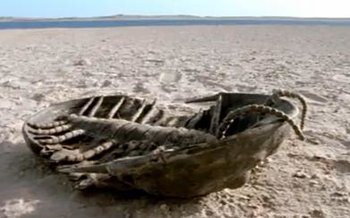
- All There in the Manual: Not named onscreen.
- Big Creepy-Crawlies: Another massive arthropod.
- Bigger Is Better: Justified, because Nigel wants to bait a large animal.
- Gentle Giant: Despite its size, it is a bottom feeder and would never endanger Nigel when it was alive.
- Living Prop: Though it mostly appears as dead prop, a living one can be seen briefly on the sea floor when Nigel is heading to meet the orthocone.
- Monster Munch: Enforced. Its only role is to be eaten by the orthocone. So much that Nigel gets annoyed when a sea scorpion tries to eat it first.
- Posthumous Character: The one used by Nigel is already dead when he picks it.
Astraspis
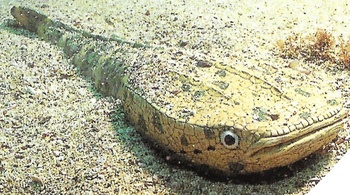
- All There in the Manual: It is not even acknowledged by name in the show.
- The Cameo: Though it can barely be counted as one as it is never shown up close.
- Posthumous Character: Nigel finds it on the beach already dead.
The Triassic
Cymbospondylus

- Always a Bigger Fish: It surprises Nigel by eating the severed tail of the Tanystropheus.
- Anachronism Stew: Cymbospondylus is only known from the Anisian (247-242 mya), not the Mid Carnian (230 mya).
- Arc Villain: The main predator of the Triassic sea.
- Composite Character: The Triassic segment is set in Switzerland and based on the Besano Formation, but the only Cymbospondylus species found there (and in Europe as a whole) is C. buchseri, which is only 5-6 meters long, while the huge size of over 10 meters is based on C. petrinus from the Favret Formation of Nevada.
- Jump Scare: It appears out of nowhere grabbing the tail of the Tanystropheus and startling Nigel.
- Mix-and-Match Critters: It looks like a cross between later ichthyosaurs (like Ophthalmosaurus in Walking with Dinosaurs) and the even later mosasaurs, who are unrelated.
- Perpetual Smiler: It's model makes it looks like it's constantly smiling, though not the kind of smile that would make you feel safe.
Nothosaurus
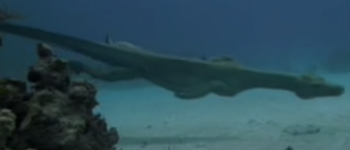

- From Nobody to Nightmare: Same stock from which plesiosaurs and pliosaurs will evolve from.
- Mix-and-Match Critters: Half crocodile, half monitor lizard, with anglerfish teeth. And the book has them reproducing like sea turtles.
- No Sense of Personal Space: They cheerfully swim up to Nigel out of curiosity. Nigel keeps a cattle prod handy in case they get too close.
- Ridiculously Cute Critter: Well, cute by
 prehistoric sea reptile standards.
prehistoric sea reptile standards. - Scary Teeth: Long like needles and sharp like knives, used to catch slippery fish.
- Weaksauce Weakness: Like crocodiles, they have strong muscles to close their mouth but the muscles opening it are weak. So he can disarm one just by grabbing its head from behind.
Tanystropheus

- Anachronism Stew: Tanystropheus is only known from the Anisian to early Carnian (247-235 mya), not the Mid Carnian (230 mya).
- Artistic License – Paleontology: Has more than a few problems. The speculative shedding tail (which is based on an obscure hypothesis by paleontologist Rupert Wild) was considered unlikely by paleobiologists even in 2003 when the special first aired. In addition to being inspired by Wild's fringe taxonomy placing Tanystropheus closer to lepidosaurs than archosaurs, such a defense mechanism would be of very questionable practicality for an aquatic reptile that likely required use of its tail for swimming. The show's depiction also has a noticeably shrink-wrapped skull, even compared to other Walking with... restorations.
- Gentle Giant: Nigel identifies it as not dangerous right away. It only eats small fish.
- Life-or-Limb Decision: The speculative tail shedding.
- Long Neck: So long, in fact, that it barely has a body!
- Mix-and-Match Critters: Half snake, half iguana.
- Noodle People: A noodle reptile.
Peteinosaurus

- Anachronism Stew: Shown around 10 million years too early. The longer-snouted Preondactylus was a closer matchnote .
- The Cameo: It is the same species seen in the first episode of Walking with Dinosaurs, and it only appears at the beginning of the segment.
- Misplaced Wildlife: Inverted. It was misplaced in "New Blood", which was set in Arizona, but it is at home here, surrounded by European animals.
- No Name Given: Only called "pterosaur".
Unnamed theropod dinosaur
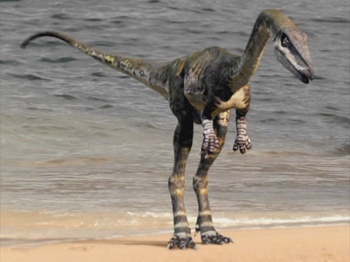
- Anachronism Stew: Obviously, there is always room for new discoveries, but there are no known theropods from this time in Europe (not identified as the location, but home to Peteinosaurus, Cymbospondylus, Nothosaurus and Tanystropheus). The closest thing is the small dinosauriform Saltopus.
- The Cameo: Only shown at the beginning of the segment.
- From Nobody to Nightmare: Shown here to say that dinosaurs have just appeared in this time. According to Nigel, they are all still small and non threatening like this one.
- Historical Villain Downgrade: Ironically, the first known theropod from Europe is Liliensternus a couple of million years later, which despite being a relative of Coelophysis was a respectable 5-meters-long beast; the smaller coelophysoids like Procompsognathus and Coelophysis itself only arrived some dozen million years later. Maybe Nigel should have worried about walking on land.
- Informed Species: The book identifies it as a "coelurosaur", but the latter term now only applies to the more derived, feathered tetanuran theropods (including tyrannosaurs), which didn't show up until the Mid Jurassic. This animal would more accurately be described as a coelophysid (as it's just a recolored Coelophysis model).
- No Name Given: Only identified as "coelurosaur" in accompanying material, probably following the old tendency to call all small theropods coelurosaurs regardless of actual philogeny. As per current definition, coelurosaurs don't appear until the Middle Jurassic.
- Suspiciously Similar Substitute: To "New Blood"'s Coelophysis. They look close enough to have been modified from the same model, but they are still different and the coat is also different. This is most likely to avoid Misplaced Wildlife as Coelophysis is a North American genus.
The Devonian
Dunkleosteus

- Arc Villain: The main predator of the Devonian sea.
- Bigger Is Better: Nigel won't set up for Stethacanthus. He wants to meet a Dunkleosteus, and a big Dunkleosteus at that.
- Cliffhanger: The first episode ends with Nigel in a shark cage, as a Dunkleosteus charges onto it.
- The Dreaded: The Ancient Mariner's crew is both fearful and looking forward to meet it.
- Eats Babies: The larger adult eats a smaller one attracted by the remains of its last meal, zero fucks given.
- Irony: It has no teeth. Those scary teeth-like things are bony plates that are actually part of its head's skeleton.
- Scary Teeth: Though they're not actually teeth.
- Vomit Indiscretion Shot: It vomits its prey's bony plates and the shark mail Nigel put on them almost as soon as it eats.
Bothriolepis

- All There in the Manual: It's not named onscreen.
- Artistic License – Paleontology: Bothriolepis was a bottom feeder that lived mostly in freshwater (although it could venture into the sea close to the shore) and ate rotten vegetarian matter. Those muscled pectoral fins were to push itself along the ground, and it could only see upwards. Here, it is shown swimming near the sea surface and catching Nigel's bait.
- The Bait: Takes the bait and is used in turn to bait the Dunkleosteus.
- Black Bead Eyes: It has two small, button-like black eyes on the top of its head.
- Monster Munch: Appears only so it can be eaten by the Dunkleosteus.
- Posthumous Character: It is killed right in its introduction and its role mostly happens when it is dead.
Stethacanthus
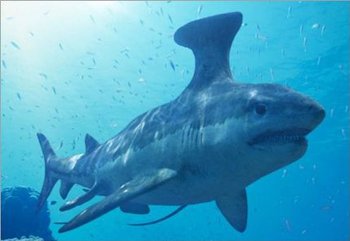
- Always Someone Better: Nigel takes notice of it because of how weird it is, but he can't wait for it to go and a Dunkleosteus to arrive. Ironically, he's in a shark cage and Stethacanthus is closer to what he would be using the cage for in real life.
- Animals Not to Scale: It appears to be average for a shark, when in reality was rather small (c. 70 cm long)
- Artistic License – Paleontology: It was also a bottom feeder, and thus unlikely to be attracted to Nigel's cage.
- Black Bead Eyes: Well, it is a shark.
- Cow Tools: Besides its long fin whips and claspers, it has a bizarre, anvil-like structure where its dorsal fin should be, and there are teeth growing out of it. Nigel speculates that it could have a role in display for mating or territoriality.
- Prehistoric Monster: Take a shark, and make it as bizarre as you can. Stethacanthus is weirder.
- Suspiciously Similar Substitute: Yet another shark that comes first and is irrelevant next to the prehistoric Sea Monster of choice.
- Threatening Shark: Subverted. The cage protects Nigel, and the Dunkleosteus he is hoping for is far worse.
The Eocene
Arsinoitherium
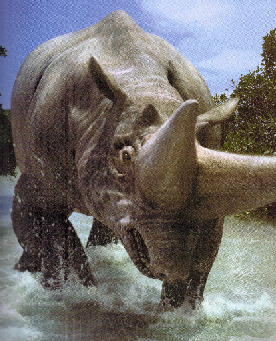
- Accidental Pun: Lampshaded by Nigel, who says that it has a "funny name".note
- All Animals Are Domesticated: Averted. It turns down Nigel's offer of food and charges at him.
- Awesome, but Impractical: Its giant horns are useful for fighting, but because of the way they're positioned, they obscure its vision.
- Graceful in Their Element: Averted. It is equally awkward on land and in water.
- Mix-and-Match Critters: One third elephant, one third rhinoceros, one third hippopotamus.
- Prehistoric Monster: One of the best Truth in Television examples. This is a rhinoceros-like animal with the horn numbers doubled, even though it's maladaptative and limits its senses.
- Rhino Rampage: Although it's more closely related to elephants.
- Rule of Cool/Sequel Escalation: Sure, they could have just reused Moeritherium, but who would have wanted that? Moeritherium would never go on Rhino Rampage against Nigel.
Dorudon
A small primitive whale. For tropes, see entry in Walking with Beasts.
Basilosaurus
The first filter whale-sized cetacean, but it is an active hunter instead of a filter feeder. For other tropes, see Walking with Beasts.
- Arc Villain: The main predator of the Eocene sea.
The Pliocene
Megalodon
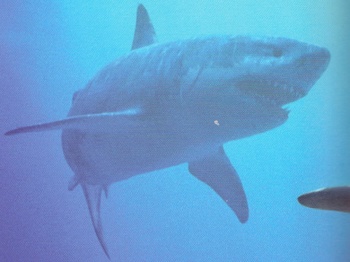
The largest shark to ever live, and an active hunter instead of a filter-feeder like the whale shark. It swam the world's oceans as recently as 4 million years ago.
- All There in the Manual: The megalodon name comes from the species name, C. megalodon. The genus is either Carcharodon or Carcharocles.
- Arc Villain: The main predator of the Pliocene sea.
- Apocalypse How: It will be killed by the Ice Age and thus miss modern humans by a geological hair breadth.
- Bigger Is Better: Nigel finds a juvenile in the coast relatively early, but he is not content until they find an adult out at sea.
- Cliffhanger: The second episode ends with the megalodon seemingly eating Nigel alive.
 This isn't the case, of course.
This isn't the case, of course. - The Dreaded: The plan to deal with an adult megalodon causes an argument among the Ancient Mariner's crew.
- Expy: Since only the teeth are known, its aspect and behavior is taken from the modern great white shark (which actually coexisted with it and is not its descendant).
- One-Hit Kill: Specialized in rushing from the deep and killing whales with one bite to the belly.
- Shark Fin of Doom: Shown thrice. One when the segment begins; another when the Ancient Mariner attracts an adult Megalodon for the first time; and the third one when it sails next to the boat and Nigel manages to stick the "shark cam" on the fin dorsal itself.
- Prehistoric Monster: What happens when you apply Animals Not to Scale to a great white shark. Sure, the show's called Sea Monsters, but Nigel does call this one a "monster" to its face.
- Suspiciously Similar Substitute: To Dunkleosteus. Both are giant fish top predators, both make fearsome sharks look pathetic in comparison, both try to get Nigel through the shark cage, and both are used for the episode's Cliffhanger.
- Threatening Shark: It makes the shark from Jaws look like a minnow. Granted, the narration turns somber when it is described that once changing climates causing the whales that it preyed on to head north, the megalodon went extinct from starvation.
Odobenocetops
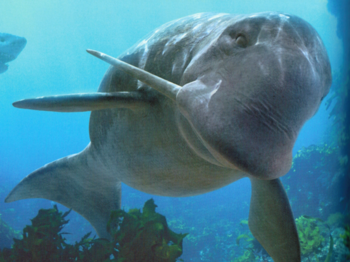
- Anachronism Stew: Actually from the Late Miocene rather than the Pliocene.
- Meaningful Name: Odobenocetops means "Whale-faced Walrus".
- Mix-and-Match Critters: Looks like a mix between a narwhal, a walrus and a manatee.
- Monster Munch: Only featured as a potential prey source for Megalodon, although it does escape the segment unharmed. The team invokes this when they disguise a camera as an Odobenocetops.
- Ridiculously Cute Critter: Seriously, why aren't there stuffed toys of this thing?
- What Measure Is a Non-Cute?: Probably why it is allowed to live.
Unnamed whale
A medium-sized filter-feeding whale hunted by the adult Megalodon.
- Impending Doom P.O.V.: Seen from the "shark cam" attached to the adult Megalodon.
- Monster Munch: Appears only as, and when the Megalodon makes it its prey.
- No Name Given: In fairness, it's most likely not meant to be a particular whale.
The Jurassic
Leedsichthys
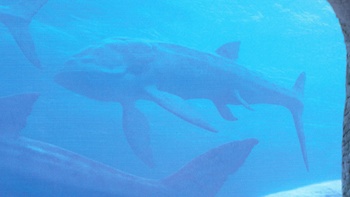
- Animals Not to Scale: Like Liopleurodon, it is much larger than the real animal actually was (about 16 meters long).
- Awesome, but Impractical: For all the awe of its size, there doesn't seem to be a real advantage to it.
- Blood Is Squicker in Water: Happens everytime a critter gets a bite out of the sick one.
- Eaten Alive: Hungry carnivores (sharks, crocodiles, and eventually pliosaurs) hang onto a sick one and begin to eat as it continues swimming. The fish could take losing a lot of pounds, but the problem is that predators just keep coming one after another.
- Gentle Giant: Extremely large, but totally harmless.
- Giant Equals Invincible: Subverted. Predators don't bother usually with hunting it due to its size, but it has no way to outrun them or fight back. Once they start eating it alive, there is no stop. Its only defense is to travel in groups and hope someone else gets eaten, much like any given fish in the Ocean.
- Mighty Glacier: They are as ridiculously slow as ridiculously gigantic.
- Mix-and-Match Critters: Your average fish + a filter feeding whale.
Metriorhynchus

- Fragile Speedster: Very fast, but lacks the armor plating of other crocodiles. As Nigel puts it, it has "sacrificed defense for speed".
- Mix-and-Match Critters: Clearly a crocodile, but with the soft skin and fins of a shark.
- Never Smile at a Crocodile: It eats chunks out of a wounded Leedsichthys, and it must be dissuaded from biting Nigel, unlike the Hybodus.
- Shed Armor, Gain Speed: Described Nigel as having done this, albeit on an evolutionary scale.
Hybodus

- Cow Tools: The head horns. Sure, they had them in Walking with Dinosaurs already, but this time their bizarre nature is explicitly addressed.
- Informed Attribute: Nigel calls them the weirdest sharks because of the horns. This is harsh, considering he met the anvil-finned Stethacanthus not long ago.
Liopleurodon
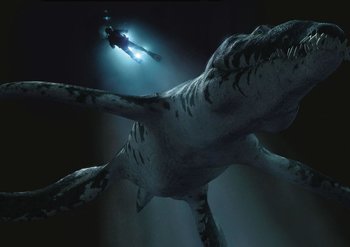
- Adaptational Wimp: It is still touted as the largest predator of all time and the crew is afraid of it, plus it gets the second place to the Jurassic all by itself. However, its omnicidal power is far removed from what it was in Walking with Dinosaurs. It only appears scavenging in this segment, first of squids used to bait juveniles and then feeding on the dead Leedsichthys.
- Arc Villain: The main predator of the Jurassic sea.
- The Nose Knows: They can feed both at night and day, because they live in "a world of smell" and are not reliant on sight according to Nigel.
- Scary Teeth: Also noted. They cut through the Leedsichthys hide like butter, while in WWD they mostly ate prey whole.
- Strong Family Resemblance: The teeth and the long face makes it instantly recognizable as a relative of Nothosaurus and Elasmosaurus, despite each being almost 100 million years apart in opposite directions.
- Weaksauce Weakness: They can be turned away by a stench that is bad enough.
The Cretaceous
Hesperornis
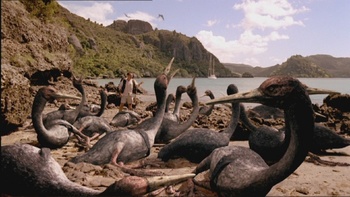
- Action Survivor: How does a bird even dare live in this sea? Nevermind a flightless bird that must actually look for its food underwater. And the land is inhabited by tyrannosaurs so they should also look the other way when on the shore.
- Feathered Fiend: Subverted. They're ugly and aggressive, but also harmless.
- Graceful in Their Element: They can't fly or even walk on land, but are graceful swimmers.
- Historical Ugliness Update: It's depicted as a gnarly, vulture-like creature with a bald, red head and a dark body, seemingly just to make it look more "prehistoric". However, there is little reason to think Hesperornis looked like this, as its closest extant analogs such as loons, grebes, penguins, and other aquatic birds look nothing like this, and most restorations of Hesperornis model it after the latter, with fully feathered heads and counter-shaded colorations.
- Mix-and-Match Critters: Like a cross between a penguin and a sea lion, but somehow bigger and uglier.
- Noisy Nature: On land, at their nesting grounds.
- Monster Munch: They exist to show how badass all the other animals are by getting eaten.
- Prehistoric Monster: Proof that nature can do this to anything. It is a seabird, but with teeth, flightless, and the size of a human. Subverted in that, despite their intimidating size and appearance, they're fairly placid towards Nigel to the point that he can walk right through the middle of their colony without triggering much of a response.
- Toothy Bird: It retains the teeth of primitive birds, and puts them to good use when catching fish (modern seabirds would probably be toothed today if all Mesozoic seabirds had not died out in the K/Pg mass extinction).
Squalicorax

- All There in the Manual: Not identified onscreen.
- Always Someone Better: Given how much else lives in this sea, it only merits a cameo, but would be a fearsome top predator almost anywhere else. In fact, the show recycles the Megalodon model for it.
- Blood Is Squicker in Water: Shown inspecting a pool of blood, although it isn't the cause of it.
- The Cameo: Only appears in this brief shot. However, it is duly noted.
- Threatening Shark: Downplayed considering this sea is filled with even more dangerous beasts.
Xiphactinus

- Always Someone Better: Like Squalicorax, it probably would have been a top predator if it lived in a different sea.
- Animals Not to Scale: The one attacking a Pteranodon is oversized to the point of easy confusion with Squalicorax or even Tylosaurus.
- Big Eater: Eating a two meter long bird in one gulp.
- Blood Is Squicker in Water: The actual perpetrator, as a result of hunting a Hesperornis.
- Early-Bird Cameo: Shown in the prologue of the series as the reason why taking a dip in Prehistory would be a bad idea. Ironically, it turns out to be one of the less threatening predators in its environment.
- Irony: A fish that eats fish-eating birds and almost eats a fish-eating pterosaur at one point.
- Nightmare Face: A perpetual one, due to its compresion.
- Red Baron: Called "the bulldog fish" due to its short face and protruding teeth.
- The Worf Effect: Eating a man-sized Hesperornis in one gulp.
Halisaurus
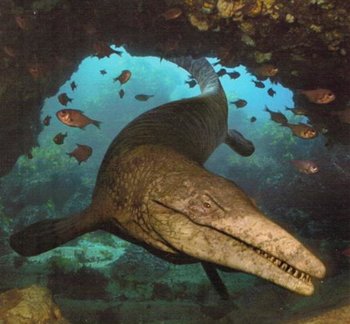
- Always Someone Better: Would qualify as a top predator if it didn't have a giant cousin.
- Lesser of Two Evils: A smaller relative of the giant Tylosaurus.
- Mix-and-Match Critters: Although related to snakes, they look more like monitor lizards, crocodiles or other sea reptiles. The snake connection is implied more in this case by having it swimming in a reef near the shore, much like a modern sea serpent.
- The Worf Effect: It lives among the shore rocks, in part, because it is scared of the large oceanic going Tylosaurus. That's what the Mariner is actually after.
Tyrannosaurus rex
Tyrannosaurus rex
A large theropod dinosaur. For other tropes, see Walking with Dinosaurs.- Anachronistic Animal: Despite being confirmed by
 Word of God, it didn't evolve until 68 million years ago. The fans have basically agreed that the tyrannosaur seen in this episode is actually the time period accurate Daspletosaurus.
Word of God, it didn't evolve until 68 million years ago. The fans have basically agreed that the tyrannosaur seen in this episode is actually the time period accurate Daspletosaurus. - The Cameo: It only appears once in the segment.
- Noisy Nature: It roars at the beach for no seeming reason. Is it trying to scare the Ancient Mariner?
- Rule of Cool: Why is it on a rock right on the sea surface? How did it even got there? Why is it roaring? Why is it there 7 million years before its time? Rule of Cool, that's why.
Pteranodon
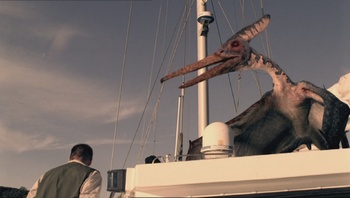
- All Animals Are Domesticated: Despite never seeing a human before, one becomes a pet to Nigel in exchange for fish. Which in turns makes this an example of Domesticated Dinosaurs.
- Anachronistic Animal: While downplayed compared to its appearance in Chased by Dinosaurs (which had it inhabiting Cenomanian Argentina for whatever reason), it's still guilty of this. Pteranodon actually lived during the late Santonian from around 86-84 mya, rather than 9 million years later in the Campanian as shown here. At least it's shown in roughly the correct geographic location this time (midwestern North America, around the fringes of the Western Interior Seaway).
- Animal Reaction Shot: The one tamed by Nigel screeches in panic when Nigel's boat is capsized.
- Giant Flyer: Not giant giant, but still big enough to qualify.
- Irony: Eats fish, almost gets eaten by a fish (Xiphactinus).
- Team Pet: One becomes this for Nigel's boat crew. Nigel feeds it fish and it sits on the boat with them. It seems to take a liking to the crew, seeing as it appears to be genuinely frightened when a mosasaur capsizes Nigel's boat.
Archelon
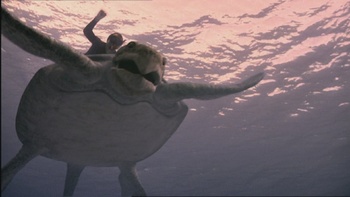
- Gentle Giant: So harmless, Nigel ignores all precautions to swim on the back of one.
- Half the Man He Used to Be: The first one encountered by the crew has been severed in half by a mosasaur attack.
- Turtle Island: Downplayed. The half turtle is found floating on the sea surface, and it is still large enough to make the boat stop. A living one can easily transport a person (or a few) on its shell. But neither would ever be mistaken for an actual island.
- The Worf Effect: Just imagine what mosasaurs can do, if they can chow through the half of this and be so confident in themselves to leave the other half.
Elasmosaurus

- Camera Abuse: One hits the underwater camera with the snout while inspecting it.
- Gentle Giant: It feeds on small fish so it is harmless to humans. They ignore the Mariner when they pass it during their migration.
- Long Neck: Its most evident feature.
- Mix-and-Match Critters: Sometimes compared to a snake rammed through a sea turtle.
- Stock Ness Monster: Pretty much how Nessie is imagined to look.
- Strong Family Resemblance: Easy to recognize as a relative of Nothosaurus and Liopleurodon due to its triangular head and fish-trap type teeth, despite being separated from either by hundreds of millions of years.
Tylosaurus

- Always a Bigger Fish: The Tylosaurus pack attacks the lifeboat sent to rescue Nigel from an earlier Xiphactinus attack. And they are natural predators to everything else seen in this episode.
- Animals Not to Scale: They are depicted as being 60 feet long, but the highest estimates for Tylosaurus only placed it at 50 feet (43 feet is more likely). It still was the most massive marine reptile in the Western Interior Seaway during its time and one of the largest known mosasaurs.
- Arc Villain: The main predator of the Cretaceous sea.
- Artistic License – Paleontology: They are depicted as pod animals, while all the other marine reptiles are shown as solitary. Given that giant mosasaurs were massive apex predators most closely related to varanids and snakes (animals who usually aren't very social) and many Tylosaurus skulls display bite marks made in intraspecific combat (implying they were very aggressive towards each other), showing them as killer whale-like pack hunters is dubious at best, and mainly serves the purpose of making them seem more dangerous than the larger Liopleurodon. note
- Camera Abuse: During the final credits, one bites at the camera.
- Cliffhanger: Zigzagged. They attack the rescue lifeboat near the episode's end, but the occupants make it to the larger ship (this would probably be left for the next episode in an actual cliffhanger). Then, The Stinger has them attack the ship in even greater numbers, while the crew is sleeping, and this would be the actual cliffhanger of the episode if it wasn't the end of the series already.
- Covers Always Lie: No, they never get near the shark cage.
- The Dreaded: This thing manages to scare Nigel's Pteranodon.
- Expy: Attacking the lifeboat after confusing it with a turtle seems taken from great white sharks, and the family bounds and concerted attacks, from killer whales.
- The Family That Slays Together: To quote the narrator: "The only thing worse than swimming with a 60-foot-long killer marine reptile... is swimming with its family."
- Final Boss: As the final apex predator of Nigel's adventure, it poses the biggest threat of the sea monsters.
- Hero Killer: Like the Megalodon, it comes close. But The Stinger implies that it succeeds.
- I Am a Humanitarian: They eat everything, including other mosasaurs. The narrator doesn't clarify if the same species of mosasaur.
- Lightning Bruiser: And they were
 even faster in Real Life.
even faster in Real Life. - Monster Is a Mommy: They travel in family groups and take care of their young. One of them can be seen swimming next to its mother when the lifeboat is attacked.
- No Name Given: Strangely, it's never called Tylosaurus (which it clearly is), only a "giant mosasaur".
- Rule of Cool: If modern snakes and lizards are any indication, it's unlikely that mosasaurs were social animals or took care of their offspring, but it is cooler to see them do so.
- Sea Monster: The straightest example of them all. Why is the Cretaceous the deadliest sea of all? Because it is filled to the brim with giant predators. What are all those predators afraid of? This guy.
- Zerg Rush: It travels in groups, and they attack all at once. And then they surround the boat...
